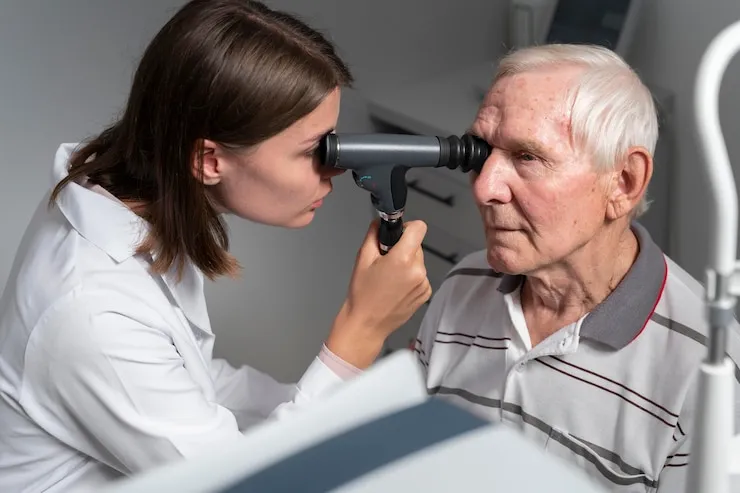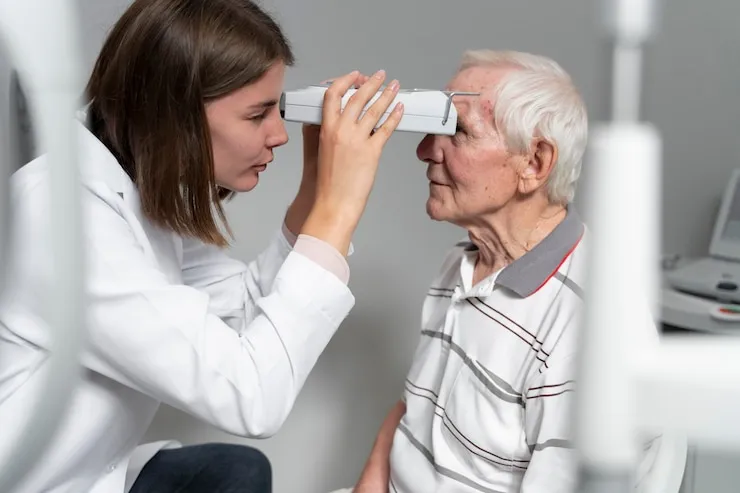
Cataract is a very common eye ailment, particularly among elderly people. Cataract is a highly common cause of blindness and poor vision worldwide, but it’s a treatable disease. If identified as early as possible and with the appropriate treatment, cataracts can be operated on, and eyesight is normal.
We will give you everything you need to know about cataracts—what they are, symptoms, causes, types, diagnosis, treatment, and prevention. The guide is easy so that you or your loved ones can learn and deal with cataracts.
What is a Cataract?
Cataract is a misting of the eye’s natural lens. The lens is an elastic, clear tissue whose job is to bend the light so that it converges to a point on the retina, and you are able to see. When you have a cataract, it keeps light from getting into the lens in a direct line, and you are unable to see foggy or blurry.
Symptoms of Cataract
Identifying the symptoms early will enable you to receive early, appropriate medical treatment. The most usual signs of cataract are mentioned below:
1. Blurred or Cloudy Vision
Your eyesight may be foggy, like viewing through a steamed window.
2. Difficulty with Night Vision
Night driving is dangerous as a result of night vision loss and amplified headlamp glare.
3. Sensitivity to Light and Glare
Light or bright lights will be bothersome or difficult to gaze at.
4. Fading or Yellowing of Colors
The colors will no longer be as vivid or yellowish in quality after some amount of time.
5. Double Vision in One Eye
You will be seeing two rather than one image, especially when viewing through the eye with a cataract.
What Causes Cataract?
Cataracts develop when proteins in the family of lenses and clog a small opening. The clogging occurs over time and leads to blindness.
Here are some common causes:
Aging
It is the most frequent reason. Proteins in the lens grow over time so that they tilt toward cataract growth.
Genetics
Genetics also come into play. If your parents or grandparents ever had cataracts, then you are likely to develop them.
Medical Conditions
Some underlying health conditions, such as diabetes, make you vulnerable to developing cataracts early in life.
Eye Injuries
Eye damage or eye surgery history can cause lens weakening and cataract formation.
Long-term Sun Exposure
Eyes’ UV sunlight exposure over a period of many years is guaranteed to speed up lens clouding.
Smoking and Alcohol Use
Cigarette smoking and alcoholism enhance your risk of getting cataracts.
Types of Cataracts
There are a few different types of cataracts based on where and how they develop in the eye.
1. Nuclear Cataracts
They develop within the center part of the lens (nucleus) and are the most frequent type which is age-related. They may bring about temporary improvement of near vision for reading, or second sight.
2. Cortical Cataracts
They originate at the periphery of the lens and run centrally downwards. They are usually white, triangular streaks.
3. Posterior Subcapsular Cataracts
They develop in the rear of the lens and can cause difficulty with reading vision, compromise daylight vision, and create glare or halos when there are lights. They also develop first.
4. Congenital Cataracts
These are present at birth or occur during childhood and are caused by genetic reasons or due to infection during pregnancy.
How is Cataract Diagnosed?
If you observe a cataract, consult an eye doctor (ophthalmologist). He/she will conduct some tests to diagnose:
- Visual Acuity Test: Examines your eyes at various distances.
- Slit-lamp Examination: A microscope is used, which allows the doctor to inspect the lens using magnification.
- Retinal Examination: The eyes are propped open wide, and then the doctor checks the retina to see if it is the one that is measuring the cataract’s diameter.
- Tonometry: It’s an intraocular pressure measurement, something that needs to be taken to rule out glaucoma.
Treatment Options for Cataracts
Can Cataracts Be Cured?
Cataracts are not curable with medication or diet, but the milky lens can be safely and successfully removed through surgery, and vision restored.
Cataract Surgery
Cataract operation is far and away the most frequent and most successful surgery of our era. Cataract operation involves the removal of the cloudy lens and the placement of an artificial clear lens called an intraocular lens (IOL) during the operation.
Types of Cataract Surgery:
- Phacoemulsification (Phaco): Most frequent procedure, where the lens is shattered with an ultrasound device and vacuumed out.
- Extracapsular Cataract Extraction (ECCE): In which the lens is removed in whole in mature cataracts.
- Laser-Assisted Cataract Surgery: Uses a femtosecond laser to provide more accuracy.
Recovery and Aftercare
Recovery will be quick in the majority of instances, and most patients will recover vision within a period of a few days of time. Always follow proper use of eye drops and no heavy weights or undue strain as instructed by your doctor.
Post-Surgery Care and Recovery
Follow proper care after cataract surgery for uneventful healing:
- Use Prescribed Eye Drops: Prevents infection and promotes healing by the use of antibiotic and anti-inflammatory eye drops.
- Avoid touching or rubbing the Eye: This will prevent the chances of infection.
- Restrict Activity: Refrain from straining, heavy lifting, swimming, or hard work for a few weeks.
- Visit Follow-Up Appointments: Your eye doctor will keep a check on healing and make necessary corrections in prescriptions.
Can Cataracts Be Prevented?
While cataracts cannot be prevented at all, they can be kept from happening at all and their onset postponed by avoiding these dangerous habits:
- Eye Protection from UV Radiation: Use 100% UVA and UVB protected glasses.
- Dense Food Nutrient: Eat foods with antioxidant richness, such as vitamins C and E, lutein, and zeaxanthin, to maintain the health of your eyes.
- Health Chronic Disorders Under Control: Diabetes and high blood pressure must be under control.
- Do Not Drink Alcohol and Smoke in moderation: Both cause additional oxidative stress to the eyes and lead to cataracts at a younger age.
- Eye Check-Ups Occasionally: The cataract will be detected early, and thus, cataracts will be in control even before they affect your lifestyle.
Living with Cataract – Tips for Daily Life
If you are not having surgery or on the waiting list to be scheduled for surgery, the following are some everyday tips about how to manage cataracts:
- Make use of more light in the reading rooms
- Don’t use low vision by using more contrast reading (black and white)
- Drive more slowly, particularly at night
- Employ routine eye testing to keep track of progress
Frequently Asked Questions
Q1. What is a cataract, and how does it affect vision?
Ans: A cataract is an eye lens opacity that otherwise remains transparent and is the cause of hazy, cloudy, or milky vision. A cataract is the result of proteins in the lens coming together and disrupting the passage of light to the retina in the correct manner.
Q2. What are the early signs of cataracts?
Ans: Early symptoms are blurred vision, halos or glare when light is reflected, night blindness, and white or yellow color. They progress and develop over a long period.
Q3. What causes cataracts to develop?
Ans: Aging is the most frequent cause, but genetics, diabetes, cigarette smoking, ultraviolet exposure, and previous eye trauma or surgery may be responsible as well.
Q4. How are cataracts diagnosed by doctors?
Ans: Physicians perform visual acuity tests, slit-lamp tests, and retinal tests in order to detect cataracts and identify the level of severity.
Q5. Can cataracts be cured or reversed without surgery?
Ans: No, the only means through which cataract can be cured is surgery. More powerful glasses are able to cure the defect in preliminary stages, but surgery only can offer crystal vision after cataract development.
Conclusion
Cataracts are a more common and avoidable reason for blindness, particularly with advancing age. Early detection and treatment of symptoms will allow you to enjoy a best quality of life. Cataract surgery is effective, safe, and restores unobstructed vision to millions of patients annually.
Practicing preventive measures such as the use of UV-spectacle glasses, a healthy diet, and regular eye checkup can miracles in keeping the eyes healthy.
If you or your loved one is suffering from cataract symptoms, don’t delay—get an eye test today and begin on the road to improved vision.
